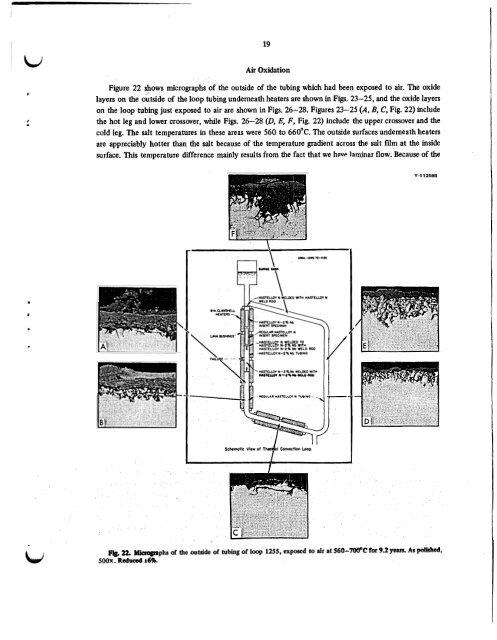Evaluation of hastelloy N alloys after nine years exposure to both a ...
Evaluation of hastelloy N alloys after nine years exposure to both a ...
Evaluation of hastelloy N alloys after nine years exposure to both a ...
Create successful ePaper yourself
Turn your PDF publications into a flip-book with our unique Google optimized e-Paper software.
.<br />
-<br />
19<br />
Air Oxidation<br />
Figure 22 shows 1 micrographs <strong>of</strong> the outside <strong>of</strong> the tubing which had been exposed <strong>to</strong> air. The oxide<br />
layers on the outside <strong>of</strong> the loop tubing underneath heaters are shown in Figs. 23-25, and the oxide layers<br />
on the loop tubing just exposed <strong>to</strong> air are shown in Figs. 26-28. Figures 23-25 (A, B, C, Fig. 22) include<br />
the hot leg and lower crossover, while Figs. 26-28 (D, E, F, Fig. 22) include the upper crossover and the<br />
cold leg. The salt temperatures in these areas were 560 <strong>to</strong> 660°C. The outside surfaces underneath heaters<br />
are appreciably hotter than the salt because <strong>of</strong> the temperature gradient across the salt film at the inside<br />
surface. This temperature difference mainly results from the fact that we have laminar flow. Because <strong>of</strong> the<br />
e<br />
\<br />
SURGE TANK<br />
-HASTELLOI N WELDED TO<br />
HASTELLOI N-2% ND WITH<br />
WASTELLOY N-2% Nb VELD ROO<br />
-WSlELLOVN-Z%Nb TUBING<br />
WnEUOY N-2ZND WELDfO WITH<br />
HASTELWY N-2ZWD WELD MH)<br />
i<br />
Schematic Vlcw <strong>of</strong> Thcr aI Convection Loop.<br />
Y<br />
Y-112589<br />
Pi. 22. Micrographs <strong>of</strong> the outside <strong>of</strong> tubing <strong>of</strong> loop 1255, exposed <strong>to</strong> air at 560-700°C for 9.2 ye=. As polished,<br />
W SOOX. Reduced 1690.



![Review of Molten Salt Reactor Physics Calculations [Disc 2]](https://img.yumpu.com/21979492/1/190x247/review-of-molten-salt-reactor-physics-calculations-disc-2.jpg?quality=85)













